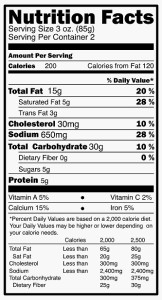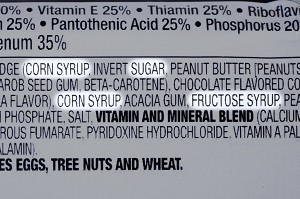Food Label Reading: Become the Expert
How can reading a food label help you? One of the best ways to arm yourself in  having a kidney-friendly diet is learning how to read food labels and using the information to make the best dietary decision for you. The label makes it easy to compare similar products and find the amounts of nutrients in each product. The following label reading skills are intended to help you make quick, educated food choices that contribute to a kidney-healthy diet.
having a kidney-friendly diet is learning how to read food labels and using the information to make the best dietary decision for you. The label makes it easy to compare similar products and find the amounts of nutrients in each product. The following label reading skills are intended to help you make quick, educated food choices that contribute to a kidney-healthy diet.
- Look at the Serving Size and the number of servings in the package. Serving Sizes are standardized to make it easier to compare foods. Packages often contain more than a single serving, which means that you may have to multiply all the amounts listed to see an accurate picture of how many calories and nutrients are in a single container.
- Check the Calories. Calories provide a measure of how much energy you get from each serving. The calories are only part of the picture when reading food labels; they can help manage your weight (maintain, lose, or gain).
- Let the Percent Daily Values be your guide. Daily Values are average levels of nutrients for a person eating 2000 calories per day. On a food label, low daily values are 5% or less. Nutrients to look for 5% or less would be saturated fat, trans-fat, cholesterol, phosphorus, potassium, and sodium. High daily values are 20% or more on the food label. Foods to aim for high percent daily value would be vitamins, minerals (except those you are limiting), and fiber.
- Carbohydrates are an important source of energy and should be
 pickedwisely. Grains, grain products, starchy vegetables, fruits, milk and yogurt are some carbohydrate sources. Sugar, syrup and sweets are also high in carbohydrates. Knowing the carbohydrate grams is helpful for those with diabetes who use the carbohydrate counting system.
pickedwisely. Grains, grain products, starchy vegetables, fruits, milk and yogurt are some carbohydrate sources. Sugar, syrup and sweets are also high in carbohydrates. Knowing the carbohydrate grams is helpful for those with diabetes who use the carbohydrate counting system. - Protein helps keep your immune system healthy and helps build, repair, and maintain your body tissues. With chronic kidney disease, protein-containing food needs to be consumed in moderation at meals. Recommended serving size is a deck of cards, equal to 3 ounces of meat.
- Potassium and phosphorus are not required to be on the food label at this time, so if they are not listed on the food label it does not mean that they are not in that food. If potassium and phosphorus are not listed on a food, you can look at the ingredient list to identify high potassium or phosphorus ingredients.
- Investigate the ingredient list! Look for specific ingredients with PHOS or potassium in the name (i.e. potassium chloride, phosphoric acid, or polyphosphates), and try to avoid these additives. Look for products with smaller ingredient lists and containing ingredients you recognize.
Learning how to read food labels puts you back in control of what you are eating on a daily basis. It will take time to become an expert, so start slow with reading a few food labels each week to better understand what your diet looks like After some practice, it will feel more natural and you will be on your way to becoming a food label reading expert!
Additional Kidney Diet Resources
Visit DaVita.com and explore these diet and nutrition resources:
DaVita Kidney-Friendly Recipes
This article is for informational purposes only and is not a substitute for medical advice or treatment. Consult your physician and dietitian regarding your specific diagnosis, treatment, diet and health questions.

Recent Comments